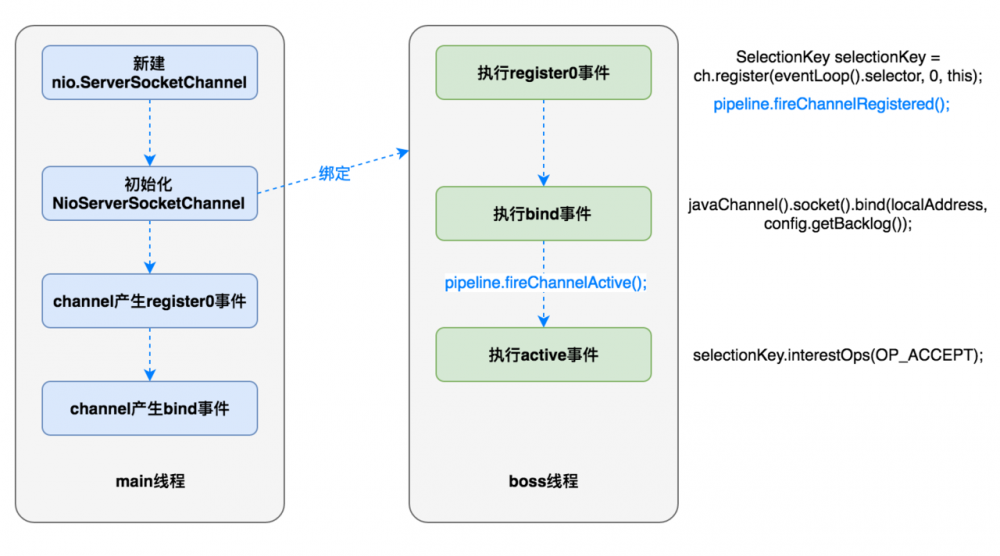Netty 学习系列六:服务端 ServerSocketChannel 绑定
零、 整体流程

1、用户在main线程启动执行ServerSocketChannel的初始化
- 1)初始化一个NioServerSocketChannel channel 包括初始化Channel关联的ch、pipeline、unsafe、config。
nio.ServerSocketChannel ch = nio.SelectorProvider.openServerSocketChannel(); ch.configBlocking(false);
- 2)将channel与ServerBootstrap的EventLoopGroup中的某个EventLoop child绑定
- 3)向child的任务执行队列中添加channel的register0事件
- 4)监听register0事件的完成状态,完成时向child的任务执行队列中添加channel的bind事件
2、EventLoop线程中执行register0事件
- 1)将NioServerSocketChannel的ch注册到NioEventLoop child的selector上
SelectionKey selectionKey = ch.register(eventLoop().selector, 0, this);
- 2)标识ChannelPromise状态为success,触发Listener将bind任务添加到EventLoop的执行任务队列
- 3)ServerSocketChannel channel产生ChannelRegisted事件
pipeline.fireChannelRegistered();
会导致ChannelInitialzer.channelRegisted()执行,将ServerBootstrapAcceptor添加到channel的pipeline中。
3、EventLoop线程中执行Channel.bind事件
- 1)ServerSocketChannel绑定对应服务端口,监听新的客户端连接
javaChannel().socket().bind(localAddress, config.getBacklog());
- 2)ServerSocketChannel channel产生ChannelActive事件
pipeline.fireChannelActive();
ChannelActive事件由HeadContext处理,向ch中添加OP_ACCEPT事件监听。
selectionKey.interestOps(OP_ACCEPT);
一、代码入口
ServerBootstrap b = new ServerBootstrap(); // Start the server. ChannelFuture f = b.bind(port).sync();
服务端启动时都会执行上面的代码,用来启动ServerSocketChannel监听对应端口。
最终由AbstractBootstrap.doBind方法处理。
private ChannelFuture doBind(final SocketAddress localAddress) {
final ChannelFuture regFuture = initAndRegister();
final Channel channel = regFuture.channel();
if (regFuture.cause() != null) {
return regFuture;
}
if (regFuture.isDone()) {
// At this point we know that the registration was complete and successful.
ChannelPromise promise = channel.newPromise();
doBind0(regFuture, channel, localAddress, promise);
return promise;
} else {
// Registration future is almost always fulfilled already, but just in case it's not.
final PendingRegistrationPromise promise = new PendingRegistrationPromise(channel);
regFuture.addListener(new ChannelFutureListener() {
public void operationComplete(ChannelFuture future) throws Exception {
Throwable cause = future.cause();
if (cause != null) {
// Registration on the EventLoop failed so fail the ChannelPromise directly to not cause an
// IllegalStateException once we try to access the EventLoop of the Channel.
promise.setFailure(cause);
} else {
// Registration was successful, so set the correct executor to use.
// See https://github.com/netty/netty/issues/2586
promise.registered();
doBind0(regFuture, channel, localAddress, promise);
}
}
});
return promise;
}
}
二、用户线程初始化NioServerSocketChannel
final Channel channel = channelFactory.newChannel();
从此行代码开始,ReflectiveChannelFactory通过反射的方式调用NioServerSocketChannel的构造方法进行channel的初始化。
1、NioServerSocketChannel的实例化
- 1)创建一个nio.ServerSocketChannel
newSocket(SelectorProvider provider);
使用nio.SelectorProvider.openServerSocketChannel()创建一个nio.ServerSocketChannel ch。
- 2)通过构造方法实例化NioServerSocketChannel,并初始化相关的field
parent = null unsafe = new NioMessageUnsafe() pipeline = new DefaultChannelPipeline(this) ->此处初始化一个DefaultChannelPipeline,并将pipeline和channel互相绑定 ch = ch ->同时将ch设置为非阻塞模式 readInterestOp = OP_ACCEPT config = new ServerSocketChannelConfig(this, javaChannel().socket())
- 3)向channel的pipeline中添加Inbound处理器ChannelInitializer
init(channel);
由其父类ServerBootstrap直接实现。
- 设置channel的attr和options
- 添加ChannelInitializer到pipeline中
p.addLast(new ChannelInitializer<Channel>() {
public void initChannel(Channel ch) throws Exception {
ChannelPipeline pipeline = ch.pipeline();
ChannelHandler handler = config.handler();
if (handler != null) {
pipeline.addLast(handler);
}
pipeline.addLast(new ServerBootstrapAcceptor(
currentChildGroup, currentChildHandler, currentChildOptions, currentChildAttrs));
}
}
该处理器的 channelRegisted事件 回调方法会将 ServerBootstrapAcceptor 加入channel的pipeline中,并将自己从pipeline中移除。
- 4)ServerBootstrapAcceptor
ServerBootstrapAcceptor也是一个Inbound处理器,用于在Server端accept新的客户端连接时,向新生成的socketChannel中添加用户定义的业务处理器。
其channelRead事件回调方法会将业务方往ServerBootstrap中添加的childHandler添加到socketChannel对应的pipeline中。
对于Server端,channelRead事件被定义为server端accept到了新的socket连接。
2、将NioServerSocketChannel注册到ServerBootstrap的EventLoopGroup上
ChannelFuture regFuture = group().register(channel);
-
1)NioEventLoopGroup的chooser从其children中选出一个NioEventLoop child,调用其register()方法进行channel注册;
-
2)实际将NioEventLoop child传给NioServerSocketChannel的unsafe,调用其register(EventLoop eventLoop, final ChannelPromise promise)方法完成注册
-
将channel.eventLoop绑定为当前NioEventLoop child;
-
将AbstractUnsafe.register0(DefaultChannelPromise promise)任务加入EventLoop child的执行任务队列;
3、给标识“register0任务”完成状态ChannelFuture添加一个Listener
doBind0(regFuture, channel, localAddress, promise);
当ChannelFuture完成时,将NioServerSocketChannel.bind(SocketAddress localAddress, ChannelPromise promise)任务加入EventLoop child的执行任务队列
三、EventLoop线程中执行register0事件
AbstractUnsafe.register0(ChannelPromise promise);
1、将NioServerSocketChannel的ch注册到NioEventLoop child的selector上,同时将注册得到的SelectionKey绑定为NioServerSocketChannel的selectionKey
doRegister();
selectionKey = javaChannel().register(eventLoop().selector, 0, this);
netty的轮询注册机制其实是将AbstractNioChannel内部的jdk类对象SelectableChannel ch注册到jdk类对象Selector selector上去,并且将AbstractNioChannel channel作为SelectableChannel对象ch的一个attachment附属上,这样在jdk轮询出某个SelectableChannel有IO事件发生时,就可以直接取出AbstractNioChannel进行后续操作。
2、标识ChannelPromise状态为success,触发Listener将bind任务添加到EventLoop的执行任务队列
safeSetSuccess(promise);
3、ServerSocketChannel channel产生ChannelRegisted事件
pipeline.fireChannelRegistered();
会导致ChannelInitialzer.channelRegisted()执行,将ServerBootstrapAcceptor添加到channel的pipeline中。
四、EventLoop线程中执行Channel.bind事件
AbstractUnsafe.bind(final SocketAddress localAddress, final ChannelPromise promise);
1、ServerSocketChannel绑定对应服务端口,监听新的客户端连接
javaChannel().socket().bind(localAddress, config.getBacklog());
2、ServerSocketChannel channel产生ChannelActive事件
pipeline.fireChannelActive();
ChannelActive事件由HeadContext处理,最终调用了AbstractNioUnsafe.doBeginRead()方法,向ch中添加OP_READ事件监听。
selectionKey.interestOps(interestOps | readInterestOp);










![[HBLOG]公众号](http://www.liuhaihua.cn/img/qrcode_gzh.jpg)

